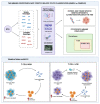Molecular Determinants of Soft Tissue Sarcoma Immunity: Targets for Immune Intervention
- PMID: 34299136
- PMCID: PMC8303572
- DOI: 10.3390/ijms22147518
Molecular Determinants of Soft Tissue Sarcoma Immunity: Targets for Immune Intervention
Abstract
Soft tissue sarcomas (STSs) are a family of rare malignant tumors encompassing more than 80 histologies. Current therapies for metastatic STS, a condition that affects roughly half of patients, have limited efficacy, making innovative therapeutic strategies urgently needed. From a molecular point of view, STSs can be classified as translocation-related and those with a heavily rearranged genotype. Although only the latter display an increased mutational burden, molecular profiles suggestive of an "immune hot" tumor microenvironment are observed across STS histologies, and response to immunotherapy has been reported in both translocation-related and genetic complex STSs. These data reinforce the notion that immunity in STSs is multifaceted and influenced by both genetic and epigenetic determinants. Cumulative evidence indicates that a fine characterization of STSs at different levels is required to identify biomarkers predictive of immunotherapy response and to discover targetable pathways to switch on the immune sensitivity of "immune cold" tumors. In this review, we will summarize recent findings on the interplay between genetic landscape, molecular profiling and immunity in STSs. Immunological and molecular features will be discussed for their prognostic value in selected STS histologies. Finally, the local and systemic immunomodulatory effects of the targeted drugs imatinib and sunitinib will be discussed.
Keywords: combination therapy; epigenetics; genetic landscape; immune profiling; immunotherapy; soft tissue sarcoma; targeted therapy; tumor microenvironment.
Conflict of interest statement
The authors declare no conflict of interest.
Figures


References
-
- Charoentong P., Finotello F., Angelova M., Mayer C., Efremova M., Rieder D., Hackl H., Trajanoski Z. Pan-Cancer Immunogenomic Analyses Reveal Genotype-Immunophenotype Relationships and Predictors of Response to Checkpoint Blockade. Cell. Rep. 2017;18:248–262. doi: 10.1016/j.celrep.2016.12.019. - DOI - PubMed
-
- Tawbi H.A., Burgess M., Bolejack V., Van Tine B.A., Schuetze S.M., Hu J., D’Angelo S., Attia S., Riedel R.F., Priebat D.A., et al. Pembrolizumab in Advanced Soft-Tissue Sarcoma and Bone Sarcoma (SARC028): A Multicentre, Two-Cohort, Single-Arm, Open-Label, Phase 2 Trial. Lancet Oncol. 2017;18:1493–1501. doi: 10.1016/S1470-2045(17)30624-1. - DOI - PMC - PubMed
Publication types
MeSH terms
Substances
Grants and funding
LinkOut - more resources
Full Text Sources
Medical

